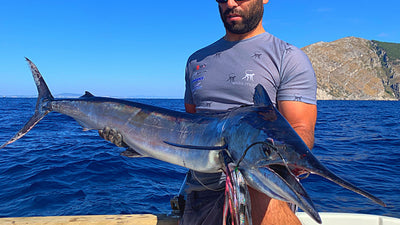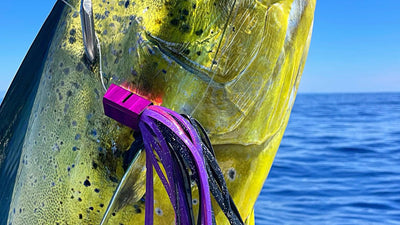Starting from the small town of Playa Samara, and pointing the bow towards the northwest, after about an hour of navigation we will find ourselves in one of the best spots for deep sea trolling in this stretch of ocean… home to billfish (with at least 5 species present) but above all large golden, immense schools of yellowfin tuna and wahoo. All this seasoned with the inevitable company of dolphins…
“Costa Rica, pura vida” , not only can you read it almost everywhere: on walls, on clothing or on tourist gadgets… but you can also hear it said all the time! Pura vida, for Costa Ricans is a mantra, a way of life , it is used as a greeting at the end of a chat, or in place of a “you’re welcome” after a “thank you”. And it actually perfectly conveys the idea of the rhythms and lifestyle that one is led to lead when one finds oneself, even just for a vacation, in a region like Guanacaste, in the north of Costa Rica… imagine those who live there all year round! Wild and immense beaches of compact sand, left in their natural state, not equipped with sunbeds or umbrellas, lush vegetation, happy people who live simply, rhythms marked by the sun: it almost seems like you forget about the clock, at 6 in the morning the beach and the town are already alive because the sun has already risen, and there are those who take advantage of it to go jogging, to surf or to relax and enjoy the view of the ocean... just as in the evening at 6 pm with the sunset a certain appetite comes over, and you find yourself having dinner at a time when in Italy you usually feel out of place even for an aperitif.

Of course, in the specific case of sport fishermen who decide to cross the Atlantic Ocean to go fishing in Costa Rica, the days will certainly be different from those of the classic nature tourists who can be very present in those areas. In fact, we will not enjoy the beach, unless we decide to wake up an hour before breakfast to be able to regenerate with some physical activity in the early morning... and in the evening when we return we will have to take a quick shower despite being tired, to be able to relax with a cocktail in front of a fantastic sunset over the Pacific Ocean. We will not go on nature excursions in the internal parks, but we will enjoy the breathtaking, apparently Jurassic scenery that the coast offers when seen from the sea: it seems like we are in a film set in the time of the dinosaurs, and we almost expect to suddenly see a pterodactyl appear from behind a mountain, or a brachiosaurus stretching its neck over the vegetation. But even without using your imagination, it will not be uncommon to encounter many other animals, both on land and in water, including squirrels, monkeys, iguanas, crocodiles, dolphins and whales...
In short, even if you spend the day in the middle of the sea, far from everything and everyone, this life will not be less pure... on the contrary! 
In the heat of a day
Finally the alarm clock will ring on the first day of fishing, and after an excellent tropical-scented breakfast enjoying the sunrise directly on the beach of Playa Samara, our daily transfer will be waiting for us to travel about 2/3 km, until we reach the natural inlet that serves as a port for the town, which is located south of the beach. Our boat will be waiting for us at anchor, with the captain already on board preparing the lines... we will get out of the car and walk barefoot towards the shoreline to use the small boat that takes care of transporting people, luggage and equipment on board the moored boats. And so, once on board, before heading out to sea, it is good practice to troll for about fifteen minutes with planer-type sinkers and coastal trolling baits (spoons, sticks, small minnows) to catch some bonito to keep alive in tuna tubes, and to use when necessary for a bait dedicated to marlin. Once the available tubes are filled, we will sail quickly pointing the bow towards the northernmost spots… about an hour of sailing, and it is already time to cast the lines.

Gear: light or heavy?
These waters offer a very varied high-altitude scenario, populated by species that are not only different in behavior and habits, but above all in size... and these are not small differences. Specifically, trolling in the same spot, with the same bait, we could find ourselves fighting with a 15/20 kg dorado or a wahoo of barely 10 kg, as well as with a 60 kg yellowfin tuna or even a marlin of several hundred kg! And if it is true that the goal is to have fun, then fishing light, that is with equipment proportionate to the size of the most widespread species (dorado, yellowfin, wahoo, sailfish) the other side of the coin could mean the risk of losing the fish of a lifetime, in the case of a fight with a large marlin, perhaps even a black one that will take off like an unstoppable train towards the bottom. On the other hand, fishing with excessively heavy equipment, while waiting for the big fish to arrive, could force us to recover most of the fish with little fun, and maybe not even be able to fight a marlin. In this case, probably the best choice could be a right mix, positioning the lighter rods (about 20 lb) in the points in the wake where they could most likely attack fish of a smaller size, and leaving the heavier rods (at least 50 lb) for the positions dedicated exclusively to the marlin, or maybe for the switch and bait. Of course, we are still talking about fishing, and we fishermen can only hazard theories or predictions, which the fish will be happy to dismantle and overturn at their pleasure. Indeed, perhaps there is only one certainty: the big fish will always bite on the lightest rod in fishing!


Techniques and setups
Even if we talk generically about deep sea trolling, we know there are a multitude of variations aimed at achieving different objectives. Usually, in these waters, it is best to fish either with a setup dedicated to small or medium-sized fish, such as dolphinfish, sailfish, tuna and wahoo, or with a specific setup for marlin, or at most with a mixed setup. In the first case, we will put at least six lines armed with kona of size between 16 and 25/30 cm, possibly also rigged with ballyhoo, or directly ballyhoo rigged with circle hook. In the specific setup for marlin, we will only tow two large teasers not far from the boat, possibly also one or more dredge in the wake, and we will have the rods ready with natural dead or live bait (boniti or ballyhoo) ready to switch in case a marlin should rise in the wake and follow the teasers. You could also think about keeping a couple of “fishing” rods in the water, in this case armed with large marlin kona rods and rigid rig. In the case of the mixed setup, the lighter rods will be placed, with smaller baits, in the furthest positions in the wake (shot gun, outriggers), while we will dedicate the part of the setup closest to the boat for the marlin, therefore hosting the teasers and possibly one or two large kona rods. In this case it is always a good idea to have the rod ready for the switch and bait.

During the days of trolling, you will find yourself in the middle of yellowfin tuna feeding grounds, which will be signaled to you by a particular species of dolphins that perform very characteristic jumps, that is, rotating on themselves in the aerial phase. On these occasions it will be very important to hold the spinning rod with a popper or stick bait, and make casts from the bow directly onto the feeding grounds. It will not be an easy fishing action, considering that the boat will continue to proceed at at least 6 knots, and that the position at the bow on which to maintain balance is quite precarious, but perhaps also for these reasons the strikes will be very adrenaline-filled and satisfying. Another way to catch tuna when they are in a school is to spin in the wake some wooden cigar-shaped lures with a lead head and armed with a single hook, called cedar plug, which are deadly if jerked continuously. Even in this case the strike will be very fun, precisely because we will have the rod in hand when it happens.

Irresistible Ballyhoo
Going out deep sea fishing every day, we will have a constant that will always accompany us: the deadly ballyhoo that will never be missing on board! They are used in different ways, precisely because they are irresistible against all the fish that can be caught in deep sea. It is a type of needlefish, whose beak is made up of only the lower jaw, while the upper one is short like a normal mouth. The body is stockier and the length is shorter... but it has the characteristic and the enormous advantage of resisting for entire days trolled at 7/8 knots. They are usually sold frozen in packaged bags, defrosted on board and prepared to be baited. The preparation consists of cutting the beak, sometimes removing the eyes and the lateral fins, to then be rigged in the kona or alone. As for the baiting in kona, a J hook is used, threading it through the gills to make it come out of the belly, and with the help of a piece of copper wire that starts from the eye of the hook, it will be artfully tied and secured along the shank. For a “naked and raw” use, it will be preferable to use waxed wire, incorporating a small olive-shaped sinker into the binding to be positioned under the head. In this case it will then be baited on a circle hook that will take hold right between the coils of the binding above the head. In both cases, the goal will be to make the fish eat the bait, or at least attack more forcefully... and to better succeed in this intent, we will fish with the clutch almost completely open: when we see a fish behind the bait, or we hear the buzzer start slightly, we will dive on the rod, remove the buzzer and fully open the clutch lever, slightly slowing down the line coming out of the spool with our thumb so as to feel when the fish takes the bait in its mouth, wait a few seconds and then start the real fight.

The operation does not always go well, but there are certainly moments of adrenaline and excitement on board that certainly contribute to transmitting much stronger emotions than a classic start with the rod in its place on the bulwark.




